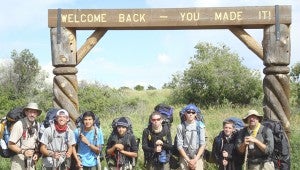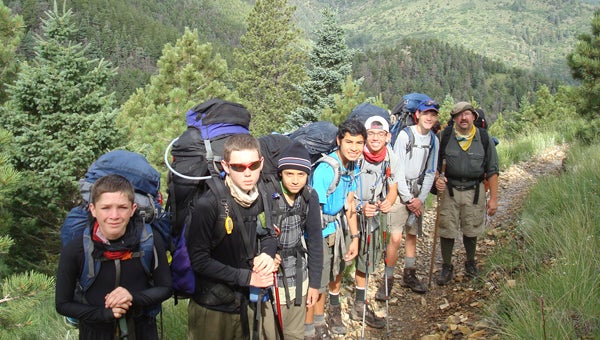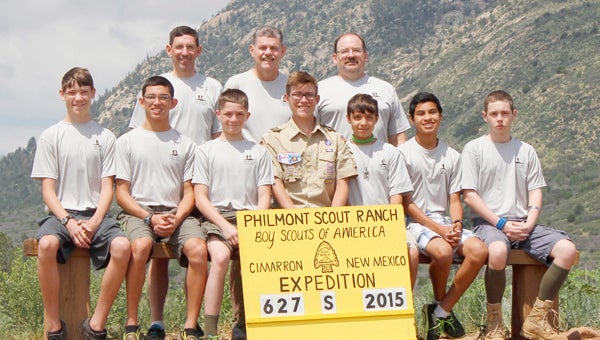MOUNTAIN TREKKERS: Douglas Topolse takes trek of a lifetime
Published 2:00 am Saturday, July 25, 2015

SUBMITTED PHOTO
Seven members of Troop 3 Boy Scouts of America from Marianna, Fla., and two members of Troop 41 from Troy, Ala., completed a 12-day, 80-mile trek in the mountains of northeastern New Mexico. They have been preparing for over a year for the trek at the BSA high adventure camp called Philmont Scout Ranch. From Marianna, Troop 3 scouts JAC Clikas, Owen Gilley, Keary Nichols, Matthew Pelham and Daniel Tillman, along with two adult advisers, David McArthur and Barry Tillman, were joined by scout Douglas Topolse and adult adviser David Runyon from Troy. Together the nine formed a trekking “crew.”
Imagine a sky so dark that it’s possible to see the individual twinkling of a million stars.
That’s Philmont Scout Ranch.
Imagine the sun so bright that its rays bounce off white rocks, blinding the eyes.
That, too, is Philmont Scout Ranch.
Douglas Topolse, a Life Scout with Boy Scout Troop 41 in Troy, recently returned from Philmont Scout Ranch in New Mexico. He said the experience will be remembered as the best of times and the worst of times and an experience for all times.
“I bought a T-shirt with a check box for ‘Number of Times a Philmont,’” Topolse said. “There are eight check boxes. I could only check one. But my goal is to check all eight.”
Topolse and Dr. David Runyan of Troop 41 joined Boy Scout Troop 3 in Marianna on a 12-day trek across the sprawling Philmont Scout Ranch, which is the Boy Scouts’ premier High Adventure base. Philmont features 214 miles of rugged northern New Mexico wilderness.
Topolse had been preparing for the12-day, 80-mile trek for about six months. He went on hikes from 10 to 42 miles. He hiked with other Scouts who had signed on for the challenges of a 12-day Philmont trek. Topolse is a skater, so he was accustomed to bending his knees and pushing his limits. He was ready for Philmont.
“I was so excited to get to base camp,” Topolse said. “I rode out with ‘Doc’ (David Runyon), who was the adult advisor for our crew. It took us three days to get there. Philmont is an amazing place. On the day that we came into camp, 92 other troops arrived. The next day, we were given our crew number 627-S. Six-Twenty-seven was the day our trek started and the letter ‘S’ corresponded to the number crew that left on that day.”
Topolse said his crew had a “before” photograph taken but he had no idea how different he and the other crew members would look when the “after” photograph was taken.
Every day for the next 12 days was an adventure and a challenge.
“The first three days, we had a crew coach with us,” Topolse said. “After that, we were left to do the rest of the trek on our own.”
Some of the trek was trudging along, putting one foot in front of the other. But the entire trek tested the mettle of the young men and their leaders.
Twelve days is a long time, and 80 miles is a long way when you’re hiking every step of the way, Topolse said. “There was some level land, but most of it was moderate slopes and steep slopes. On an eight percent slope, every 100 feet you trekked you went up eight feet. That was hard trekking.”
Hiking Big Red at 11,000 feet above sea level provided an even greater challenge than expected.
“We were above the timberline so there were no trees and the air was thinner,” Topolse said. “Hiking was already difficult and then there came a storm with thunder, lightning and hail. The hail was large and it hurt. There was nowhere for us to take shelter, and we were still 10 miles from our base camp. That was a big challenge for us.”
Topolse said there are two types of base camps at Philmont, a staff camp and a trail camp.
“At the staff camp, there are things to do, like blacksmithing, black powder rifle shooting and horseback riding,” he said. “At the trail camps, we just ate, rested and did chores around the campsite – going to the stream to get water and cleaning the fire pit.”
For the Scouts, there were no burgers hot off the grill or fish to fry.
“We only ate things that you could add water to,” Topolse said. “We did have beef jerky and granola bars. My personal favorite meal was maple brown sugar oatmeal, packaged orange juice and a granola bar.”
The one cooked meal the Scouts had was at the chuck wagon.
“Most things were related to time periods at Philmont, so we had a trail dinner,” Topolse said. “The dinner was cooked in cast iron pots. We had stew, cornbread and cobbler, and it was good!”
On the trail, the Scouts packed their food and the food bags were not lightweight.
“Some of the time, we were carrying packs that weighed 60 to 70 pounds,” Topolse said.
Along the trails there were places of interest. One of those was the site of a plane crash – a U.S. bomber from the 1940s.
“Scouts used to get to stand on the wings of the bomber and have their pictures taken – walking on wings at 10,000 feet — but no one is allowed to do that now because of the condition of the plane,” Topolse said. “I would like to have done that.”
The days along the trail were hot, sometimes getting up to 100 degrees or more. Nights could be pleasant at around 68 degrees or extremely cold, from 30 to 20 degrees, depending on the altitude.
“On top of some of the mountains we would be so close to the sun that the sun would soak into the red rocks and burn your feet and bounce off the white rocks and send a glare into your eyes,” Topolse said. “The nights were different. One night, we were called out of our tents and told to gather at a big tree. We were out there in our pajamas, rubbing our eyes. Our leader told us to step back five steps and look up. It was the most beautiful thing I had ever seen. A full moon with millions of stars. And, there was one bird flying across the sky. An eagle. I’ll never forget that.”
Other nights, the sky would turn purple and the natural light from the moon and stars would be so bright that it would have been possible to read a book.
The nights were as amazing and the days were hot and dry.
On the last day of the 12-day, 80-mile trek, Topolse said his crew approached the Trail of Tears.
“You could see the base camp, and then the trail would switch and you couldn’t see it,” he said. “It was that way for what seemed like forever. ‘Where did base camp go?’ There were 62 switchbacks on the Trail of Tears. When we finally saw base camp for real, we all wanted to run to it.”
For those who venture the 12-day trek at Philmont Scout Ranch, there are several stages of emotions.
“First, you are excited to be there,” Topolse said. “You’re all pumped up and ready to go. On days two and three, you experience grief. It’s hot, your pack is heavy and you are trudging from one camp to the next. Two miles seems like 200 miles. Then you come to a fork in the trail and take the wrong fork and have to go back. You don’t make that mistake again.”
Then comes the pain and suffering from the physical strains of the trek.
“You can’t pick up your foot high enough to step over the rocks. Every part of our body hurts,” Topolse, said. “You wonder why you’re there. You want to go home.
“Then, comes denial. You can’t believe it’s happening. It’s just a bad dream that you want to go away. ‘Somebody, please wake me up.’”
Acceptance comes next, and you just want to get the heck out of there, Topolse said.
“Then, comes my personal favorite,” he said. “Excitement again. You go running down the trail knowing that you have done it. You have met the challenge of Philmont Scout Ranch. That is real excitement.”
Topolse stood with his crew, waiting for their “after” photograph to be taken. The trekkers were dirty and grimy. They were 12 days older and much wiser in the ways of Mother Nature’s wilderness. They felt pretty good about themselves and what they had accomplished. It showed in the “after.”
But for Topolse, the “after” photo taken on July 11, 2015 was the beginning of a lifetime affection for a place called Philmont Scout Ranch. He will be back.
- SUBMITTED PHOTO Seven members of Troop 3 Boy Scouts of America from Marianna, Fla., and two members of Troop 41 from Troy, Ala., completed a 12-day, 80-mile trek in the mountains of northeastern New Mexico. They have been preparing for over a year for the trek at the BSA high adventure camp called Philmont Scout Ranch. From Marianna, Troop 3 scouts JAC Clikas, Owen Gilley, Keary Nichols, Matthew Pelham and Daniel Tillman, along with two adult advisers, David McArthur and Barry Tillman, were joined by scout Douglas Topolse and adult adviser David Runyon from Troy. Together the nine formed a trekking “crew.”
- SUBMITTED PHOTO Seven members of Troop 3 Boy Scouts of America from Marianna, Fla., and two members of Troop 41 from Troy, Ala., completed a 12-day, 80-mile trek in the mountains of northeastern New Mexico. They have been preparing for over a year for the trek at the BSA high adventure camp called Philmont Scout Ranch. From Marianna, Troop 3 scouts JAC Clikas, Owen Gilley, Keary Nichols, Matthew Pelham and Daniel Tillman, along with two adult advisers, David McArthur and Barry Tillman, were joined by scout Douglas Topolse and adult adviser David Runyon from Troy. Together the nine formed a trekking “crew.”





